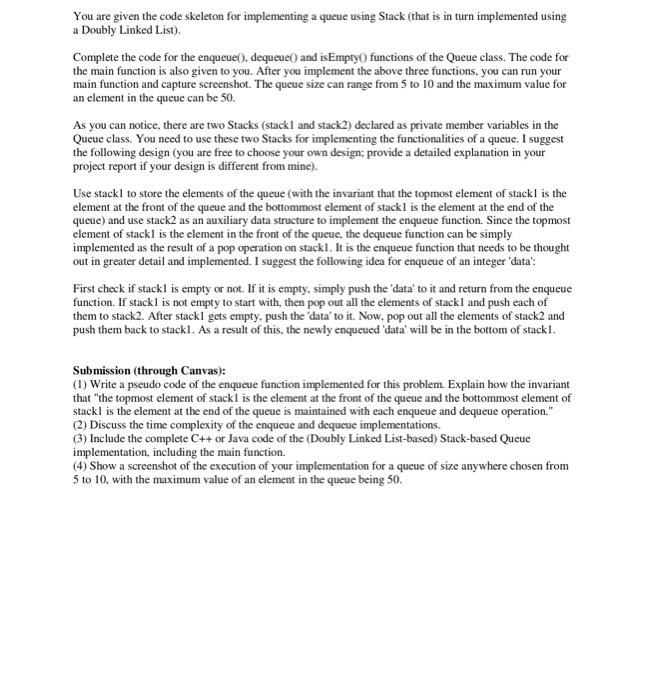Question
#include #include //srand, rand #include //clock_t, clock, CLOCKS_PER_SEC using namespace std; // implementing a queue using Stack class Node{ private: int data; Node* nextNodePtr; Node*

#include
#include
#include
using namespace std;
// implementing a queue using Stack
class Node{
private:
int data;
Node* nextNodePtr;
Node* prevNodePtr;
public:
Node(){}
void setData(int d){
data = d;
}
int getData(){
return data;
}
void setNextNodePtr(Node* nodePtr){
nextNodePtr = nodePtr;
}
Node* getNextNodePtr(){
return nextNodePtr;
}
void setPrevNodePtr(Node* nodePtr){
prevNodePtr = nodePtr;
}
Node* getPrevNodePtr(){
return prevNodePtr;
}
};
class Stack{
private:
Node* headPtr;
Node* tailPtr;
public:
Stack(){
headPtr = new Node();
tailPtr = new Node();
headPtr->setNextNodePtr(0);
tailPtr->setPrevNodePtr(0);
}
Node* getHeadPtr(){
return headPtr;
}
Node* getTailPtr(){
return tailPtr;
}
bool isEmpty(){
if (headPtr->getNextNodePtr() == 0)
return true;
return false;
}
void push(int data){
Node* newNodePtr = new Node();
newNodePtr->setData(data);
newNodePtr->setNextNodePtr(0);
Node* lastNodePtr = tailPtr->getPrevNodePtr();
if (lastNodePtr == 0){
headPtr->setNextNodePtr(newNodePtr);
newNodePtr->setPrevNodePtr(0);
}
else{
lastNodePtr->setNextNodePtr(newNodePtr);
newNodePtr->setPrevNodePtr(lastNodePtr);
}
tailPtr->setPrevNodePtr(newNodePtr);
}
int pop(){
Node* lastNodePtr = tailPtr->getPrevNodePtr();
Node* prevNodePtr = 0;
int poppedData = -100000; //empty stack
if (lastNodePtr != 0){
prevNodePtr = lastNodePtr->getPrevNodePtr();
poppedData = lastNodePtr->getData();
}
else
return poppedData;
if (prevNodePtr != 0){
prevNodePtr->setNextNodePtr(0);
tailPtr->setPrevNodePtr(prevNodePtr);
}
else{
headPtr->setNextNodePtr(0);
tailPtr->setPrevNodePtr(0);
}
return poppedData;
}
int peek(){
Node* lastNodePtr = tailPtr->getPrevNodePtr();
if (lastNodePtr != 0)
return lastNodePtr->getData();
else
return -100000; // empty stack
}
void IterativePrint(){
Node* currentNodePtr = headPtr->getNextNodePtr();
while (currentNodePtr != 0){
cout getData()
currentNodePtr = currentNodePtr->getNextNodePtr();
}
cout
}
void ReversePrint(){
Node* currentNodePtr = tailPtr->getPrevNodePtr();
while (currentNodePtr != 0){
cout getData()
currentNodePtr = currentNodePtr->getPrevNodePtr();
}
cout
}
};
class Queue{
private:
Stack stack1;
Stack stack2;
public:
Queue(){}
void enqueue(int data){
// complete the code for the enqueue function
}
int dequeue(){
// complete the code for the dequeue function
}
bool isEmpty(){
// complete the code for the isEmpty function
}
};
int main(){
int queueSize;
cout
cin >> queueSize;
Queue queue; // Create an empty queue
srand(time(NULL));
int maxValue;
cout
cin >> maxValue;
for (int i = 0; i
int value = rand() % maxValue;
queue.enqueue(value);
cout
}
cout
while (!queue.isEmpty()){
cout
}
cout
return 0;
}
Step by Step Solution
There are 3 Steps involved in it
Step: 1

Get Instant Access to Expert-Tailored Solutions
See step-by-step solutions with expert insights and AI powered tools for academic success
Step: 2

Step: 3

Ace Your Homework with AI
Get the answers you need in no time with our AI-driven, step-by-step assistance
Get Started


